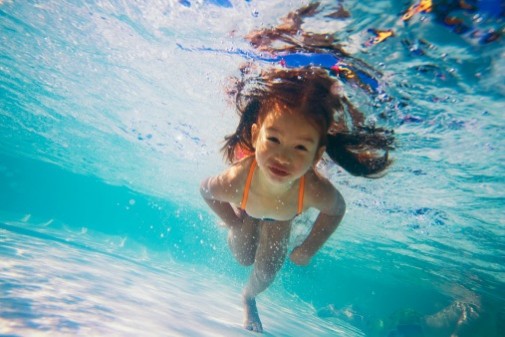CDC issues warning about dangers of shallow water blackouts

A new report from Centers for Disease Control and Prevention says that shallow-water blackouts can lead to injury or death for swimmers no matter what their skill level. And with pool season in full swing, the report is giving parents something new to worry about.
Extended periods of time can lead to fainting, subsequent drowning and possible death – regardless of how experienced the swimmer may be, said the CDC. The most common situation for this is when swimmers test how long they can hold their breath underwater.
Specific actions can be taken to help prevent such tragedies, physicians say.
Dr. John Howard, a pediatric emergency physician at Advocate Children’s Hospital in Park Ridge, Ill., recommends having an open discussion with children about how dangerous this breath-holding challenge truly is.
“Children do not think anything serious can happen if they are in the shallow end of a pool or if they are strong swimmers,” says Dr. Howard. “Promoting awareness of this tragic and completely preventable situation is the first place parents should start.”
Howard also explains to parents that warning signs of drowning may be subtle and easily missed.
“Struggle and significant noise do not always accompany drowning. Fatigue is the more likely culprit,” Dr. Howard says.
The American Academy of Pediatrics provides these warning signs for swimmers who may be drowning:
- Head low in the water, mouth at water level
- Head tilted back with mouth open
- Eyes glassy and empty, unable to focus
- Eyes closed
- Hair over forehead or eyes
- Not using legs to swim
- Hyperventilating or gasping
- Trying to swim in a particular direction, but not making progress
- Trying to roll over onto the back
About 10 people die every day from unintentional drowning, according to the Centers for Disease and Control. Of these, two will be children age 14 or younger.
To learn more about this dangerous challenge, visit shallow water blackouts.
Related Posts
Comments
6 Comments
About the Author
health enews staff is a group of experienced writers from our Advocate Health Care and Aurora Health Care sites, which also includes freelance or intern writers.


















Is this really a new game??? I pretty sure this game is like the first game ever played in water by any human…and calling it the breath-holding challenge to make it sound like some new social media inspired death trap is just weird. Just remember young children are not smart and are skilled in very few things, especially breathing underwater! Enroll your kids in swim lessons today, so they have the confidence in the water when they need it!
Anon,
I was another slow day at Advocate (a headline really more appropriate for a Friday) and they needed to incorporate some shock value to get you, me and every other sucker out there to open the article. That “game” is as old as both people and water.
Hi Jefferson and Anon,
Thanks for your comments. While it’s not a “new” game, the story is based on a new CDC report. We have updated our story to ensure the message is clear. We hope this story does serve as a good reminder to parents and even adults alike to be extra cautious in the water.
Thanks for reading!
First, what anon said. Second, the human body is remarkably wired for survival. When kids have been underwater too long for their body’s needs, guess what happens? They come up.
Just what the world needs, another article about something for parents to worry about.
Personally, I think it is a good reminder. Even though it’s a game many have played as children, it doesn’t mean the risk should be ignored. I don’t believe the author meant to “shock” anyone, but rather as a reminder of the danger of playing this game.
I’m puzzled by this article, because holding your breath to retrieve something on the bottom is part of a game that most swim instructors and parents play with their students often. Holding your breath isn’t the threat, it’s the ‘fainting game’ that is dangerous.
When I took swimming lessons at the YMCA as a child, one of the requirements before you were allowed to enter the deep end was a timed exercise holding your breath under water in the shallow end. You had to submerge and try to stay under till they blew the whistle indicating you’d passed that portion of the deep end qualifications. With practice, many of us later could dive into the deep end and swim half the distance of the regulation pool on one breath.
These activities are quite different than the ‘fainting game’ where the kids intetionally hyperventilate for a head rush. The article doesn’t distinguish between purposely hyperventilating for a buzz and simply taking deep breaths to increase your underwater time.
Pool safety discussions are important, but the most effective tool is having one set of eyes on each of your kids in the pool at all times. Go with a second adult and take shifts, and do not depend on the overworked lifeguards to notice when your child looks unsteady or is approaching danger.